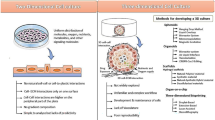Summary
Glycylhistidyllysine (GHL), a tripeptide isolated from plasma, has been shown to alter the growth rate of many cell types and organisms in culture systems. The tripeptide is optimally active at concentrations between 10 and 200 ng/ml. Some of the more interesting uses of GHL are highlighted in this paper. Present information suggests that GHL functions as a transporter of transition metals, in particular copper, to the cell surface for up-take into the cell.
Similar content being viewed by others
References
Pickart, L.; Thaler, M. Tripeptide in human serum which prolongs survival of normal liver cells and stimulates the growth of hepatoma cells. Nature New Biol. 243: 85–87; 1973.
Schlesinger, D. H.; Pickart, L.; Thaler, M. Growth-modulating tripeptide is H-Gly-His-Lys-OH. Experientia 33: 324–325; 1977.
Pickart, L.; Thayer, L.; Thaler, M. A synthetic tripeptide which increases survival of normal liver cells and stimulates the growth of hepatoma cells. Biochem. Biophys. Res. Commun. 54: 562–566; 1973.
Ambesi-Impiombato, F. S.; Parks, L. A. M.; Coon, H. G. Culture of hormone-dependent functional epithelial cells from rat thyroids. Proc. Natl. Acad. Sci. USA 77: 3455–3459; 1980.
Robertson J. A. Bromothymol blue broth; improved medium for detection of ureaplasma urealyticum (T-strain mycoplasma). J. Clin. Microbiol. 7: 127–132; 1978.
Stromberg, B. E.; Khoury, P. B.; Soulsby, E. J. L. Development of larvae ofAscaris suum from the third to the fourth stage in a chemically defined medium. Int. J. Parasitol. 7: 149–151; 1977.
Dessaint, J. P.; Camus, D.; Fischer, E.; Capron, A. Inhibition of lymphocyte proliferation by factor(s) produced bySchistosoma mansoni. Eur. J. Immunol. 7: 624–629; 1977.
Sensenbrenner, M.; Jaros, G. G.; Moonen, G.; Mandel, P. Effects of synthetic tripeptide on the differentiation of dissociated cerebral hemisphere nerve cells in culture. Neurobiology 5: 207–213. 1975.
Lindner, G.; Gross, G.; Halle, W.; Henklein, P. Über die Wirkung eines synthetischen tripeptids auf in vitro kultiviertes nervengewebe. Z. Mikrosk.-Anat. Forsch. Leipzig. 93: 820–828; 1979.
Simon, W. E.; Holzel, F. Hormone sensitivity of gynecological tumor cells in tissue culture. J. Cancer Res. Clin. Oncol. 94: 307–323; 1979.
Capron, M.; Capron, A.; Torpier G.; Bazin, H.; Bout, D.; Joseph, M. Eosinophil-dependent cytotoxicity in rat schistosomiasis. Involvement of IgG2a antibody and the role of mast cells. Eur. J. Immunol. 8: 127–133; 1978.
Svanberg, L.; Astedt, B. Release of plasminogen activator from normal and neoplastic endometrium. Experientia 35: 818–819; 1979.
Leung, M. K.; Fessler, L. J.; Greenberg, D. B.; Fessler, J. H. Separate amino and carboxyl procollagen peptidases in chick embryo tendon. J. Biol. Chem. 254: 224–232; 1979.
Astedt, B.; Barlow, G.; Holmberg, L. Time-related release of various molecular forms of urokinase in tissue culture. Thrombosis Res. 11: 149–153; 1977.
Eriksson, S.; Alm, R.; Astedt, B. Organ cultures of human fetal hepatocytes in the study of extra-and intracellular {ie466-1}. Biochem. Biophys. Acta 542: 496–505; 1978.
Joseph, M.; Dessaint, J. P.; Capron, A. Characteristics of macrophage cytotoxicity induced by IgE immune complexes. Cell Immunol. 34: 247–258; 1977.
Capron, M.; Rousseaux, J.; Mazingue, C.; Bazin, H.; Capron, A. Rat mast cell-eosinophil interaction in antibody-dependent eosinophil cytotoxicity toSchistosoma mansoni schistosomula. J. Immunol. 121: 2518–2526; 1978.
Mazingue, C.; Dessaint, J. P.; Capron, A. [3H]Serotonin release: an improved method to measure mast cell degranulation. J. Immunol. Methods 21: 65–77; 1978.
Holmberg, L.; Lecander, I.; Persson, B.; Astedt, B. An inhibitor from placenta specifically binds urokinase and inhibits plasminogen activator released from ovarian carcinoma in tissue culture. Biochem. Biophys. Acta 544: 128–137; 1978.
Slotta, K. H.; Golub, A. L.; Lopez, V. The cell growth-promoting factor. Hoppe-Seyler's Z. Physiol. Chem. 356: 367–376; 1975.
Torpier, G.; Quaissi, M. A.; Capron, A. Freezefracture study of immune-inducedSchistosoma mansoni membrane alterations. J. Ultrastruct. Res. 67: 276–287; 1979.
Pickart, L.; Thaler, M. M.; Millard M. M. Effect of transition metals on recovery from plasma of the growth-modulating tripeptide glycylhistidyllysine (GHL). J. Chromatogr. 175: 65–73; 1979.
Pickart, L.; Thaler, M. M. Growth-modulating tripeptide (Glycylhistidyllysine): association with copper and iron in plasma, and stimulation of adhesiveness and growth of hepatoma cells in culture by tripeptide-metal ion complexes. J. Cell. Physiol. 102: 129–139; 1980.
Pickart, L.; Thaler, M. M. Growth-modulating human plasma tripeptide: Relationship between molecular structure and DNA synthesis in hepatoma cells. FEBS Lett. 104: 119–122; 1979.
Aoyagi, Y.; Ikenaka, T.; Ichida, F. Copper (II)-binding ability of human alpha-fetoprotein. Cancer Res. 38: 3483–3486; 1978.
Pickart, L.; Thaler, M. M. Glycylhistidyllysine facilitates uptake of copper by hepatoma cells (abstr.). Fed. Proc. 38: 668; 1979.
Pickart, L.; Freedman, J. H.; Loker, W. J.; Peisach, J.; Perkins, C. M.; Stenkamp, R. E.; Weinstein, B. Growth-modulating plasma tripeptide may function by facilitating copper uptake into cells. Nature 288: 715–717; 1980.
Hayashi, I.; Sato, G. H. Replacement of serum by hormones permits growth of cells in a defined medium. Nature 259: 132–134; 1976.
Author information
Authors and Affiliations
Additional information
This work was supported by USPHS Grants CA 28858 and RR 05588.
Rights and permissions
About this article
Cite this article
Pickart, L. The use of glycylhistidyllysine in culture systems. In Vitro 17, 459–466 (1981). https://doi.org/10.1007/BF02633506
Received:
Accepted:
Issue Date:
DOI: https://doi.org/10.1007/BF02633506




